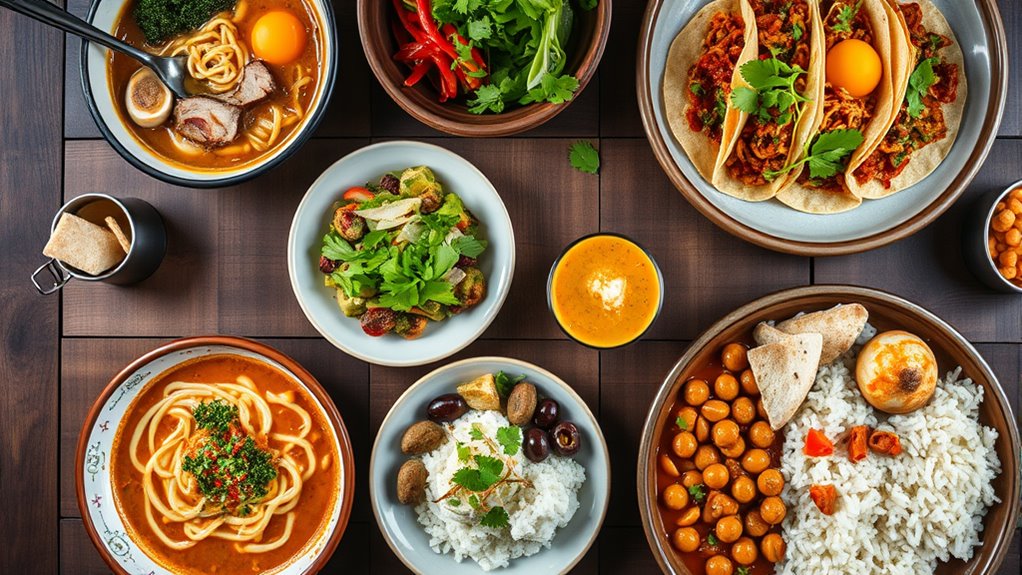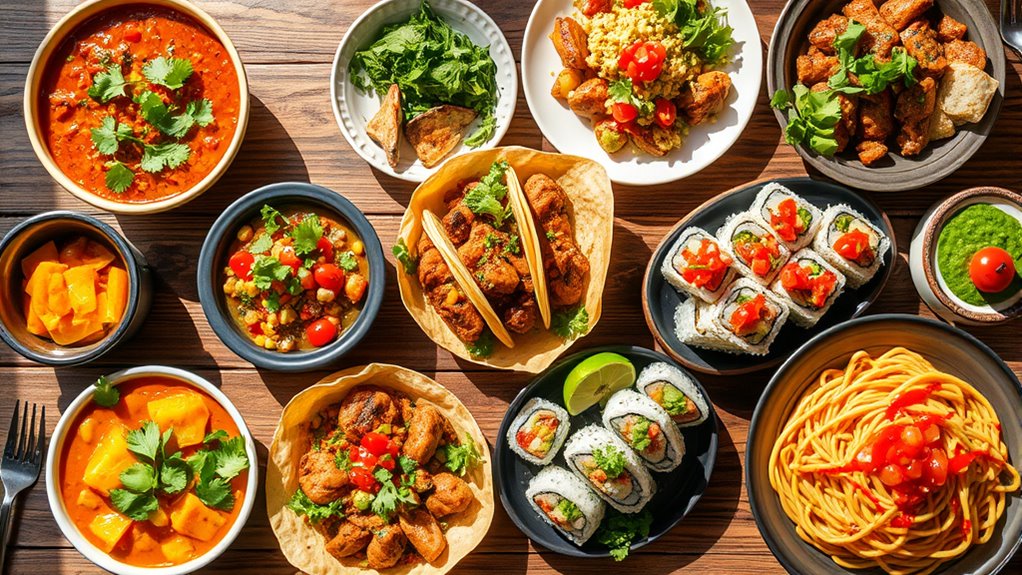Incorporating international cuisines into your meal planning adds excitement, authentic flavors, and cultural techniques to your dishes. Using spice blends like garam masala or za’atar can quickly transform simple ingredients into global favorites. Experimenting with different cooking methods, such as slow simmering or stir-frying, helps recreate authentic tastes. By exploring these flavors and techniques, you can turn everyday meals into delicious international adventures—continue exploring to discover how to master these vibrant cuisines.
Key Takeaways
- Incorporate authentic spice blends like garam masala or za’atar to quickly add global flavor profiles.
- Experiment with international cooking techniques such as stir-frying or slow simmering to enhance authenticity.
- Use proper tools and ingredients, including specific oils and cooking vessels, to elevate the taste of global dishes.
- Plan diverse meals that celebrate cultural diversity, turning everyday cooking into a global culinary experience.
- Customize spice levels and ingredient choices to suit personal preferences while exploring new international cuisines.

Incorporating international cuisines into your meal planning adds excitement and variety to everyday dining. One of the easiest ways to do this is by experimenting with different spice blends. These blends are the backbone of many global dishes, offering authentic flavors with minimal effort. Whether you’re making a fragrant Indian curry or a smoky Mexican stew, spice blends like garam masala, za’atar, or chili powder instantly transport your taste buds to another part of the world. The key is to understand the balance of spices—some blends are bold and fiery, while others are subtle and aromatic. By customizing these mixtures to suit your preferences, you can create dishes that are both familiar and adventurous. Incorporating spice blends into your cooking allows you to explore new recipes without needing a deep knowledge of international cuisines. It’s a simple, effective way to introduce global flavors into your meals. Additionally, mastering different cooking techniques is essential for making international dishes authentically. Every cuisine has its signature methods, whether it’s the slow simmering of Italian braises, the quick stir-frying of Chinese stir-fries, or the grilling techniques used in Middle Eastern kebabs. Learning these techniques helps you develop the skills necessary to replicate authentic flavors at home. For example, searing meat at high heat can mimic the smoky char of a barbecue, while slow cooking can develop deep, complex flavors typical of many Indian or Moroccan dishes. Using proper techniques ensures that the spices and ingredients come together harmoniously, creating a dish that truly reflects its cultural origins. Additionally, understanding how to cook with different oils, herbs, and cooking vessels can elevate your dishes from simple to authentic. To deepen your understanding, exploring cultural cooking methods can further enhance the authenticity of your dishes. Finally, combining the use of spice blends with the right cooking techniques allows you to build a solid foundation for exploring international cuisines. It’s about more than just following recipes; it’s about immersing yourself in the process and developing a feel for how flavors and textures come together. When you take the time to learn these techniques and embrace the vibrant world of spice blends, you’ll find yourself making dishes that are not only delicious but also a genuine celebration of global diversity. This approach keeps your meals interesting and encourages you to continually experiment with new ingredients and methods, turning your kitchen into a mini-world tour. The result? A repertoire of dishes that are flavorful, authentic, and uniquely your own.
Frequently Asked Questions
How Can I Adapt International Recipes for Dietary Restrictions?
You can adapt international recipes for dietary restrictions by swapping ingredients. For gluten-free adaptations, replace wheat-based products with rice, corn, or gluten-free flours. For vegan substitutions, use plant-based options like tofu or tempeh instead of meat, and coconut milk or vegetable broth instead of dairy. These simple changes let you enjoy global flavors while respecting your dietary needs. Experiment and have fun customizing recipes to suit your lifestyle.
What Are Budget-Friendly Ways to Incorporate Global Flavors?
Imagine turning your kitchen into a bustling market street without breaking the bank! You can do this by experimenting with spice blending—think smoky paprika or zesty cumin—and regional condiments like soy sauce or harissa, which transform simple dishes into vibrant, authentic flavors. Buying spices in bulk and exploring local ethnic markets makes it budget-friendly. These small tweaks will have your meals bursting with international flair without draining your wallet!
How Do I Find Authentic International Ingredients Locally?
You can find authentic international ingredients locally by exploring local markets and specialty shops. These places often carry spices, sauces, and unique produce from around the world. Ask vendors for recommendations and look for stores that focus on specific regional cuisines. Additionally, check out ethnic neighborhoods in your area, where small shops often stock genuine ingredients. This way, you get the real flavors without needing to go far.
Can International Cuisines Be Made Healthy and Low-Calorie?
Yes, you can make international cuisines healthy and low-calorie by choosing vegetarian options and adjusting spice levels. Incorporate fresh vegetables, lean proteins, and herbs to boost flavor without extra calories. Reduce oil and sugar, and use spices to enhance taste instead of high-calorie sauces. You’ll enjoy authentic flavors while keeping your meals nutritious and satisfying, making international dishes both delicious and health-conscious.
How Do I Introduce Children to International Flavors?
Jump in with both feet to introduce children to international flavors. You can start by involving them in cultural appreciation activities, like cooking together or exploring stories behind the dishes. Offer small taste tests of flavorful, mild dishes from different countries, encouraging flavor exploration. Make it fun and engaging, and they’ll develop an open mind and palate. Remember, patience is key—gradually, their curiosity and love for global cuisines will grow.
Conclusion
So, next time you’re stuck in a dinner rut, toss in some kimchi or curry—your taste buds will thank you (or at least be confused). Who needs boring old spaghetti every week? Embrace the chaos of international flavors and make meal planning exciting again. After all, life’s too short for bland food and predictable menus. Bon appétit! Or as they say somewhere, “Eat globally, suffer locally.”









